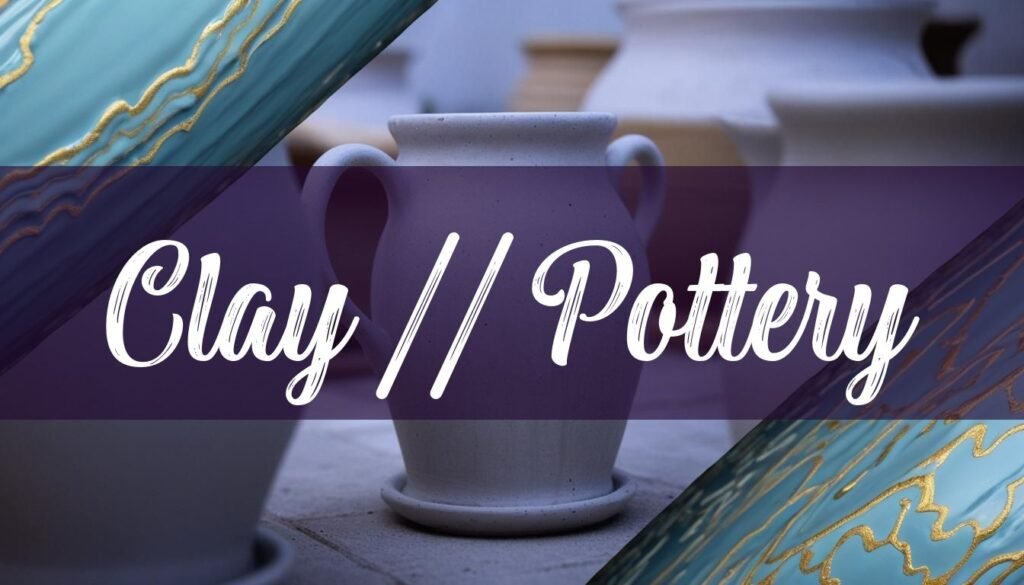Choosing the right clay is a foundational step for anyone venturing into the world of pottery at home. With various types available, each possessing unique characteristics and firing requirements, selecting the appropriate clay can significantly impact the success and enjoyment of your pottery journey. For beginners, the focus should be on clays that are easy to work with, forgiving, and suitable for the equipment and resources available at home. Understanding the properties of different clays and their firing ranges is essential for creating beautiful and durable ceramic pieces. You can read more about clay types on this page.
Earthenware Clay: A Beginner’s Best Friend
Earthenware clay stands out as an excellent choice for novice potters due to its workability and low firing temperature requirements. This type of clay is known for its high plasticity, making it easy to shape and mold, which is particularly beneficial for those still developing their skills. Earthenware typically matures at temperatures between 1745°F (950°C) and 2012°F (1100°C), making it compatible with most home kilns or accessible community firings. A guide to kiln temperatures can be found in this article. Terracotta, a popular form of earthenware, is widely used for creating decorative items, plant pots, and other functional pieces. Its relatively low firing temperature also means it won’t shrink, warp, or sag excessively during the firing process, reducing the risk of common issues that beginners face.
Moreover, earthenware’s porous nature after firing makes it ideal for certain glazing techniques, allowing for vibrant colors and interesting textures. However, it’s worth noting that earthenware is not as durable as other types of clay, and finished pieces may not be suitable for high-stress applications. More information is available here.
Stoneware Clay: Durability and Versatility
For those seeking greater durability and versatility, stoneware clay presents an attractive alternative. Stoneware is a mid-range to high-fire clay, requiring firing temperatures between 2000°F and 2400°F (1093°C and 1316°C). This higher firing range results in a stronger, less porous final product, making stoneware suitable for functional items like dinnerware, kitchenware, and vases. While stoneware demands more from your kiln and firing schedule, its robustness and resistance to chipping and cracking make it a popular choice for pieces intended for everyday use. Check out this kiln firing chart.
Stoneware clay bodies often contain minimal impurities and iron content, contributing to their strength and durability. Cone 6 and Cone 10 are the most common firing temperatures for mid-range and high-fire stoneware, respectively. Before choosing stoneware, it’s essential to ensure that your kiln can reach and maintain the necessary temperatures for proper maturation. Additional data can be found on this page.
Considerations for Setting Up a Home Pottery Studio
Setting up a home pottery studio involves careful planning to ensure a safe, efficient, and enjoyable workspace. Minimizing dust is paramount, as clay dust can be harmful to your health. Opt for spaces with wipeable surfaces like vinyl or tile flooring, avoiding carpets or difficult-to-mop floors. Kitchens, bathrooms, or garages with painted concrete floors are ideal. If carpeted areas are unavoidable, use plastic sheeting or matting that can be easily cleaned. Adequate ventilation is crucial, especially when firing a kiln, to remove fumes and ensure proper air circulation. More tips can be found here.
A dedicated sink for cleaning tools and hands is highly recommended to prevent clay from clogging household drains. If a separate sink isn’t feasible, the three-bucket system offers a practical solution. Label three buckets (1, 2, 3), using bucket 1 for the initial rinse, bucket 2 for a second cleaning, and bucket 3 for a final rinse with mostly clean water. When bucket 1 becomes full of sediment, reclaim the clay and rotate the buckets accordingly. Shelving is essential for drying greenware, storing bisque-fired pieces, and unloading the kiln. Aim for at least three shelves to accommodate each stage of the pottery process. Good lighting is also crucial, especially for those working in the evenings. Check out this article for more information.
Organizing your studio space into distinct zones can enhance efficiency. A wedging station with a sturdy table and a plasterboard or canvas-covered plywood top is essential for preparing clay. The wheel or hand-building station should be located nearby, with ample space for tools and materials. A shelving station in another corner provides a designated area for drying and storing pieces. More information is available on this page. Essential tools for a beginner potter include a needle tool, ribs (metal, wood, and rubber), wire tools, sponges, bats, knives, trimming tools, and glazing brushes. This toolbox may be helpful in setting up your work space. Other useful items are aprons, chamois cloths, fettling knives, loop tools, ribbon tools, calipers, and brushes. Safety should always be a top priority when working with clay and kilns. Guidance on clay recycling can help manage studio waste and conserve resources. To further enhance your glazing skills, explore resources like this potter’s guide to engobe application, an excellent way to add depth and color to your pieces.
Easy Pottery Projects for Beginners at Home
For beginners eager to start creating, several simple pottery projects can be easily accomplished at home. Coil pottery is an excellent technique that doesn’t require a wheel. By rolling clay into coils and layering them to build a form, you can create strong and unique pots. Pinch pots are another simple project, involving shaping a ball of clay into a small pot using your fingers. Slab pottery allows for constructing structured creations like vases or cups by joining flat pieces of clay. Some pottery project ideas are here.
Other beginner-friendly projects include egg cups, jewelry dishes, vases, mugs, milk jugs, soap dishes, and spoon rests. These projects offer opportunities to practice basic techniques and experiment with different shapes and designs. Clay decorations, beads, and tea light candle holders are also easy to make and can add a personal touch to your home. Remember, the goal is to have fun and explore the creative possibilities of clay. Additional ideas are available on Pinterest.
Common Mistakes and How to Avoid Them
Beginner potters often encounter common mistakes that can hinder their progress. Improper wedging can lead to air pockets in the clay, making it difficult to work with and increasing the risk of explosions in the kiln. Ensure thorough wedging to remove air bubbles and create a consistent clay body. Water management is crucial; too little water can make the clay hard to shape, while too much water can cause it to collapse. Strive for a balance, keeping the clay malleable but not overly soft. An article on pottery wheel mistakes is here.
Centering the clay properly on the wheel is essential for creating even and stable forms. Practice centering consistently until it becomes second nature. Inconsistent wall thickness can result in weak spots and structural instability. Pay close attention to the thickness of the walls as you shape your piece, using your hands and tools to maintain an even consistency. Rushing the drying process can lead to cracking or warping. Allow your piece to dry gradually, covering it loosely with plastic to slow the drying rate. Here’s an additional resource on mistakes to avoid.
Uneven glaze application can result in runs, pools, or undesirable textures. Apply glaze evenly and in thin layers, ensuring your pottery is clean before glazing. Not securing joints properly in hand building can cause pieces to fall apart. Always score and slip the surfaces you plan to join to create a strong bond. By being aware of these common pitfalls and learning how to avoid them, you can elevate your pottery skills and create beautiful, functional pieces. Another article on mistakes is here.





